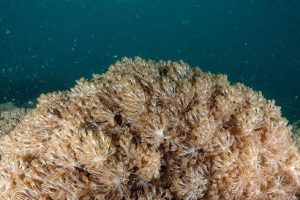Pulsing Coral
Pulsing Coral (Unomia stolonifera)
Description:
- Pinkish-white, long-tentacled soft coral
- Called pulsing coral for its dance-like movement underwater
- Branching stalk with unclustered polyps growing along (Benayahu et al. 2021)
Habitat:
- 0.5 to 20 m depths (Ruiz-Allais et al. 2021)
- Can grow on both hard (rock, coral) and soft substrates (sediment) (Ruiz-Allais et al. 2014; Ruiz-Allais et al. 2021)
Impacts & Concern:
- Overgrows reefs, including stony corals and seagrass beds, with the potential to decrease fish stocks (Ruiz-Allais et al. 2021)
- Grows quickly, can easily propagate by fragmentation, and attaches to floating debris
- May be able to attach to vessel hulls
- Has a strong rotten fish smell that can spread to the surrounding reef
- No known natural predators (Ruiz-Allais et al. 2021)
Introduction:
- Likely an aquarium dumping or release
- First found in Joint Base Pearl Harbor-Hickam in 2020. Now covers 82 acres in Pearl Harbor, including overgrowing colonies of native stony corals
- Invasive in Venezuela as a result of aquarium dumping (Ruiz-Allais et al. 2021), where it has impacted over 60 miles of reef
Distribution in Hawaiʻi:
- Kauai: Not documented
- Oʻahu: Pearl Harbor*
- Molokai: Not documented
- Lanai: Not documented
- Maui: Not documented
- Big Island: Not documented
*U. stolonifera is not found anywhere else in the United States currently
Related AIS Team Management Projects:
- AIS is collaborating with CGAPS, DoD, Bishop Museum, USFWS, NOAA, UH, and colleagues from DAR as a part of the Hawaiʻi Invasive Octocorals Working Group on the U. stolonifera infestation within Pearl Harbor
News:
Regulations:
- Restricted for private and commercial use including for research by universities or government agencies, exhibition in municipal zoos or government-affiliated aquariums, for other institutions for medical or scientific purposes (§4-71-6.5)
- Does not include individual possession of an animal as a pet
Cnidarian Database:
Invasive Cnidarian Survey Report form: https://arcg.is/LH89D2
Dashboard:
References:
- Benayahu, Y., van Ofwegen, L., Ruiz-Allais, J., & McFadden, C. (2021). Revisiting the type of Cespitularia stolonifera Gohar, 1938 leads to the description of a new genus and a species of the family Xeniidae (Octocorallia, Alcyonacea). Zootaxa, 4964(2). 330-344. 10.11646/zootaxa.4964.2.5
- Ruiz-Allais, J., Amaro, M.E., McFadden, C., & Halasz, A. (2014). The first incidence of an alien soft coral of the family Xeniidae in the Caribbean, an invasion in eastern Venezuelan coral communities. Coral Reefs, 33(2). 287-287. 10.1007/s00338-013-1122-1
- Ruiz-Allais, J., Benayahu, Y. & Lasso-Alcalá, O. (2021). The invasive octocoral Unomia stolonifera (Alcyonacea, Xeniidae) is dominating the benthos in the Southeastern Caribbean Sea. Memoria, 79. 63-80. 10.5281/zenodo.4784709

